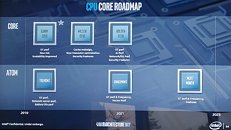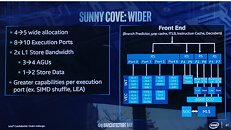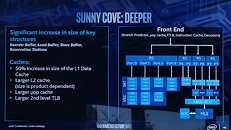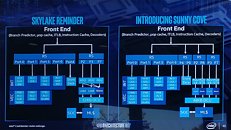Wednesday, December 12th 2018

Intel Unveils a Clean-slate CPU Core Architecture Codenamed "Sunny Cove"
Intel today unveiled its first clean-slate CPU core micro-architecture since "Nehalem," codenamed "Sunny Cove." Over the past decade, the 9-odd generations of Core processors were based on incrementally refined descendants of "Nehalem," running all the way down to "Coffee Lake." Intel now wants a clean-slate core design, much like AMD "Zen" is a clean-slate compared to "Stars" or to a large extent even "Bulldozer." This allows Intel to introduce significant gains in IPC (single-thread performance) over the current generation. Intel's IPC growth curve over the past three micro-architectures has remained flat, and only grew single-digit percentages over the generations prior.
It's important to note here, that "Sunny Cove" is the codename for the core design. Intel's earlier codenaming was all-encompassing, covering not just cores, but also uncore, and entire dies. It's up to Intel's future chip-designers to design dies with many of these cores, a future-generation iGPU such as Gen11, and a next-generation uncore that probably integrates PCIe gen 4.0 and DDR5 memory. Intel details "Sunny Cove" as far as mentioning IPC gains, a new ISA (new instruction sets and hardware capabilities, including AVX-512), and improved scalability (ability to increase core-counts without running into latency problems).The first products featuring "Sunny Cove" cores is slated as early as by 2019, and will be built on Intel's 10 nm DUV silicon fabrication process. Intel didn't stop at "Sunny Cove," and went on to mention two of its successors. "Willow Cove" is an incremental update, letting its designers eke out more effective IPC by improving on-die caches, transistor optimization, and the addition of new security features. In many ways, "Sunnycove" and "Willow Cove" relate to each other like AMD's "Zen" and "Zen+." The first "Willow Cove" based processors will launch in 2020, based on a refined 10 nm process node.Lastly there's "Golden Cove," slated for 2021. Here Intel could take advantage of a newer silicon fabrication process (either an extremely refined 10 nm-derivative or even 7 nm EUV), to increase IPC (single-thread performance). In addition, Intel will improve the core's "AI performance" (probably the ability to multiply matrices), and improved host-signal processing for 5G and networking.
Intel's low-power architectures see "Tremont" succeed "Goldmont" in 2019, packing increased IPC, battery management, and network HSP. "Gracemont," slated for 2021, will improve IPC further, and improve "Vector performance," possibly heralding AVX in some form to the low-power architecture. Gracemont is succeeded by "next" mont (Intel hasn't decided a codename yet) in 2022+, with even higher IPC.
Source:
Anandtech
It's important to note here, that "Sunny Cove" is the codename for the core design. Intel's earlier codenaming was all-encompassing, covering not just cores, but also uncore, and entire dies. It's up to Intel's future chip-designers to design dies with many of these cores, a future-generation iGPU such as Gen11, and a next-generation uncore that probably integrates PCIe gen 4.0 and DDR5 memory. Intel details "Sunny Cove" as far as mentioning IPC gains, a new ISA (new instruction sets and hardware capabilities, including AVX-512), and improved scalability (ability to increase core-counts without running into latency problems).The first products featuring "Sunny Cove" cores is slated as early as by 2019, and will be built on Intel's 10 nm DUV silicon fabrication process. Intel didn't stop at "Sunny Cove," and went on to mention two of its successors. "Willow Cove" is an incremental update, letting its designers eke out more effective IPC by improving on-die caches, transistor optimization, and the addition of new security features. In many ways, "Sunnycove" and "Willow Cove" relate to each other like AMD's "Zen" and "Zen+." The first "Willow Cove" based processors will launch in 2020, based on a refined 10 nm process node.Lastly there's "Golden Cove," slated for 2021. Here Intel could take advantage of a newer silicon fabrication process (either an extremely refined 10 nm-derivative or even 7 nm EUV), to increase IPC (single-thread performance). In addition, Intel will improve the core's "AI performance" (probably the ability to multiply matrices), and improved host-signal processing for 5G and networking.
Intel's low-power architectures see "Tremont" succeed "Goldmont" in 2019, packing increased IPC, battery management, and network HSP. "Gracemont," slated for 2021, will improve IPC further, and improve "Vector performance," possibly heralding AVX in some form to the low-power architecture. Gracemont is succeeded by "next" mont (Intel hasn't decided a codename yet) in 2022+, with even higher IPC.





57 Comments on Intel Unveils a Clean-slate CPU Core Architecture Codenamed "Sunny Cove"
Code names are great for flashy, techno-babble-filled press releases, vaporware is not.
And neither are moar incremental, miniscule performance increases that come with the least-innovative, lowest-cost approach to design, layout and I/O architectures...
Intel's been talking this same ole same same crapola for many many years, and has yet to deliver anything significantly different than previous generations, except for maybe continually increased prices and flashier retail packaging :(
One important quote from Anandtech which should have been mentioned:It's worth emphasizing that this CPU architecture have been in development longer than any recent x86 architecture from Intel. The Ice Lake core was in fact finished in design 1.5 years ago, but has been held back by a faulty node.
I guess we wait and see if they can offer something new here or if it's just a very slight improvement over what they currently offer.
Does Intel even prove read their own PR stuff these days?
seriously good job on the clickbait title tho nothing '`new'` here move along
Otherwise, very meh so far announcement.
??
It's funny to see someone defending a company that steals, lies and bribes people.
To me this looks more like the jump from Haswell to Skylake.
But who knows, maybe there is more than meets the eye.
On a more serious note, Intel is catching up on AMD's 'going wide' thought instead of IPC performance. People really need to step back and see the forest through the trees though. More cores/threads aren't needed by the masses. Hell most enthusiasts will happily run a 4c/8t CPU and not lose any performance. The fact is, to me, both companies CPUs have their merits. AMD is a great offering for those who need more threads at cores at the same pricepoint and is OK in a very slight IPC deficit. Intel just plain old has the fastest around in IPC, is lacking in core count for the same price, and overclocks better than AMD. It does indeed cost more.
So, thanks, AMD, for multiple generations of being dozens of % slower IPC, finally getting into the ballpark and adding more cores and threads people don't need? Again, so few people need the cores/threads, I'd rather them both work on 4-6c/8-12t count CPUs and improving those than simply adding what amounts to useless (for a vast majority) c/t.I didn't say it was all AMD's 'fault'.. but simply responding to Metroid's assertion that it was AMD which caused this change. Surely competition is a part of it... nice for AMD to be back in the game. But let's not forget how business works while lambasting the other side.
Competition is good!
Not on this forum but lots of other places, wow is Intel desperate or what :rolleyes:
It's a further evolved skylake ,bigger caches , more avx extensions and another load unit? , thats it besides a few extra unit's thrown in the av decoder??(thats not even in the cpu) , not the clean sheet design they claim.